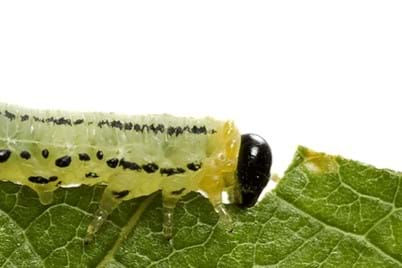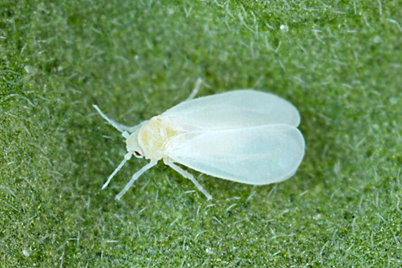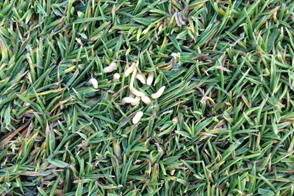
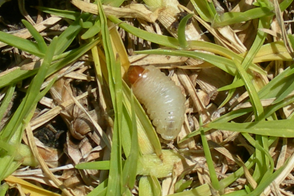
Argentine Stem Weevil and Billbug are both weevils, which are technically members of the beetle family Curculionidae. There are more than 6,000 species of weevils in Australia, and they all have a few things in common:
- weevil larvae are all legless grubs with distinct heads
- adult weevils have elbowed antennae and usually long 'snouts' (rostrum).
Argentine Stem Weevils and Billbugs are more damaging as larvae than as adult weevils.
Argentine Stem Weevil (Listronotus bonariensis) is an introduced pest from South America. Its native range includes the countries of Argentina, Bolivia, Brazil, Chile and Uruguay. Argentine Stem Weevil has been present in Australia and New Zealand since the 1920's. Exactly how the pest arrived is unknown, but one theory is that being a grassland species, the weevil was present in stockfeed on trading ships. Argentine stem weevil is found across the southern half of Australia including Tasmania.
Billbug (Sphenosphorus brunnipennis), also known as 'La Plata weevil', is native to the same countries in South America as the Argentine Stem Weevil. Billbug has also been present in Australia and New Zealand since the 1920's. It's mode of arrival is uncertain, but probably similar to how Argentine Stem Weevil arrived. Once considered a sporadic pest of turf, Billbug is now considered to be quite serious. This pest has been detected in parts of Queensland, New South Wales, Victoria, South Australia, and Western Australia.
Best treatment for Argentine Stem Weevil Larvae & Billbug Larvae
Try Yates Grub Kill and Protect for the control of Argentine Stem Weevil larvae and Billbug larvae in lawns. The product also controls other lawn beetle pests including African Black Beetle larvae, Curl Grubs, and Argentinian Scarab larvae; and lawn caterpillar pests including Lawn Armyworm, Sod Webworm, and Black Cutworm.
The secret to pest control in lawns is to keep an eye on your lawn, so that you can detect pest incursions early. It pays to know what to look for so check out Symptoms of Argentine Stem Weevil larvae & Billbug larvae Damage. If you find damage look closer to see if you can find grubs (larvae) and identify them from the Description below.
Prevention is always better than cure, and you are more likely to achieve that if you are out and about in your garden regularly. There are several things that you can do to prevent serious damage from weevil larvae (see How to Prevent Argentine Stem Weevil larvae & Billbug larvae Appearing).
Regular monitoring of your lawn will ensure that a major infestation of Argentine Stem Weevil larvae and Billbug larvae doesn't appear 'overnight'. All treatments are way more effective if you can catch an infestation in its early stages.
Well cared-for lawns and garden plants are more likely to resist, and recover from, weevil larvae attack than neglected ones.
What are Argentine Stem Weevil Larvae & Billbug Larvae and How to Get Rid of Them
Argentine Stem Weevil Larvae and Billbug Larvae are the juvenile stage of weevils. Larvae cause more damage than the adult weevils. They are legless which should help you differentiate between weevil larvae and other types of lawn grubs that you may find. The larvae of weevil pests usually feed inside their host plants rather than out in the open.
Description:
Larvae:
Argentine Stem Weevil larvae are cream coloured, legless grubs up to 5 mm long, tapering at either end, with a small light brown head.
Billbug larvae are robust, creamy white, legless grubs up to about 9 mm long, with an orange-brown head. The middle segments of the abdomen are expanded, giving the grub an inflated appearance. This characteristic is not found in other turf damaging weevil larvae.
Adults:
Argentine Stem Weevil adults are grey-brown in colour and about 3 mm long. The adult weevils are nocturnal and usually hide in the soil or lawn thatch during the day.
Billbug adults are about 9 mm long, roughly oval shaped, dark brown to black, with brown coloured longitudinal striations on their backs.
Life Cycle:
Adult Argentine Stem Weevils emerge in spring and lay tiny eggs inside grass leaves. Larvae hatch after 10 to 30 days (depending on weather) and pass through several growth stages over 2 to 3 weeks. Larvae pupate in the soil at a depth of about 5 mm. After a couple of weeks a new generation of adult weevils emerges. There may be three or four generations per year between August and May. Argentine Stem Weevils overwinter as adults.
Adult Billbugs feed on grass stems by walking backwards with their rostrum inserted, leaving a longitudinal slit. Females lay their eggs in the slits. When larvae hatch from the eggs they initially feed in grass stems but later they leave the grass stems and fall to the ground, where they may feed nearer the soil surface. Mature larvae then pupate just below the soil surface. There are usually two generations per year. Billbugs overwinter as adults, and may be active from August onwards.
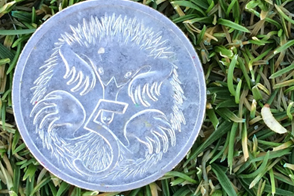
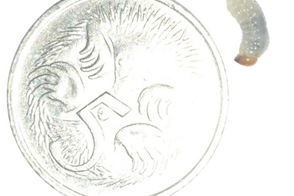
What Plants are Impacted by Argentine Stem Weevil Larvae & Billbug Larvae
Argentine Stem Weevil Larvae are pests of cool season grasses, including bent grass, ryegrasses and Kentucky bluegrass. Argentine Stem Weevil Larvae feed inside grass stems and when larger may also feed in the crown of the grass, and later move into the soil to feed on the roots. Adult Argentine Stem Weevils feed at night on grass leaves, usually near the crown or stem.
Billbug Larvae are pests of warm season grasses, especially kikuyu and sometimes couch. When larvae hatch from the eggs they initially tunnel up and down the grass stems. As they grow larger the larvae may feed on rhizomes, stolons and crowns, cutting leaves off from the roots.
Symptoms of Argentine Stem Weevil Larvae & Billbug Larvae
- Adult Argentine Stem Weevils cause minor damage such as grass leaves silvering near the tip.
- Argentine Stem Weevil Larvae cause grass leaves to wilt and brown off.
- Crown damage from Billbug Larvae feeding causes turf to initially turn yellow and then turn brown.
- Yellow and/or brown patches may appear in lawns.
- In summer dead turf can easily be pulled away from the soil.
How to Prevent Argentine Stem Weevil Larvae & Billbug Larvae Appearing
Monitor
- Look for brown patches of lawn, where the lawn changes from lush green to dull brown quite suddenly. This is typical Argentine Stem Weevil larvae damage.
- Look for adult Argentine Stem Weevils hiding in soil, or larvae inside grass stems to confirm. Argentine stem weevil damage is often mistaken for drought stress.
- Watch for small yellow or brown patches appearing in lawns caused by Billbug Larvae. The worst damage by Billbug Larvae usually occurs between November and February.
- Check lawns if birds are pecking at the ground.
Prevent
- Lawns mown short are more at risk because they are already under stress.
- A healthy lawn can recover from mild pest infestations. Help your lawn recover by watering and feeding appropriately.
Natural enemies:
- Treat lawn with beneficial nematodes. Nematodes are roundworms that live in soil and kill beetle grubs by penetrating their bodies and breeding inside them. Beneficial nematodes are available commercially and can simply be watered into the lawn.
- Unfortunately birds pecking at weevil larvae may cause as much damage as the weevil larvae.


